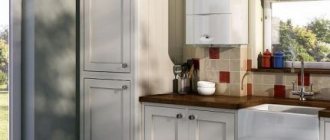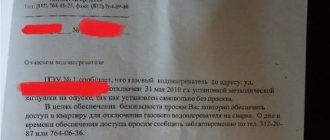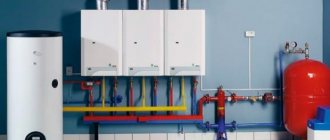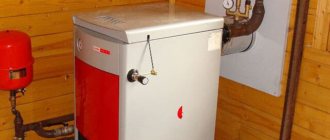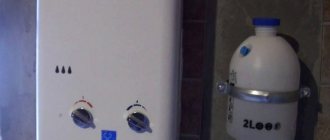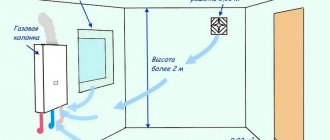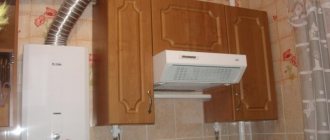Instantaneous gas water heaters are a traditional attribute of old housing stock. This type of equipment is little known to owners of apartments in high-rise buildings with centralized hot water supply. However, the owners of Khrushchev buildings still actively exploit it. Not all of them know how to install a gas water heater in an apartment.
Agree, this issue needs a thorough analysis. Illiterate installation of a gas processing unit will result in a serious threat. The information contained in our very useful article will help you eliminate the slightest risks. We will introduce you to all the intricacies and details of the installation process.
The carefully verified and systematized information we present is supported by photo collections and videos. With us you will receive complete answers to all possible questions that arise when connecting gas units.
If the column has already been installed before
When changing a water heater in case of malfunction, the device passport must also be replaced. If you install a gas water heater yourself, then the passport of the new device will not contain notes on commissioning and inspections.
According to fire safety requirements, gas equipment in homes must be inspected annually. Unauthorized replacement of a water heater will not go unnoticed and most likely the device will be turned off and sealed
After receiving the comment, it will be necessary to reconnect the column, inviting certified specialists.
Their responsibilities include inspecting the ventilation system. In older homes, they may become clogged with debris. It is dangerous to operate clogged ventilation ducts. This can cause carbon monoxide poisoning, which can be fatal. If the decision to install the water heater yourself is made, then first of all you need to check the ventilation.
If a gas water heater is not provided
In a house where the installation of gas equipment, such as a stove, is permitted, the installation of a water heater may be prohibited. This restriction applies to houses with more than 11 floors. No regulatory authority will issue permission to install a water heater in such an apartment, as this is dangerous for the residents.
If the kitchen is combined with a living room, this makes the use of gas appliances illegal. These limitations must be taken into account before redevelopment. The same can be applied to apartments where there is no kitchen or is shared.
If the house does not fall under these restrictions, then it is necessary to collect a package of documents to register the device.
The procedure is as follows:
- Write an application to the gas distribution company.
- Get a plan from the BTI or Rosreestr.
- Provide an extract from Rosreestr confirming ownership.
- Contact a specialized organization to draw up a project.
- Find certified specialists from an organization that has access to gas work.
After this, specialists will make an insert into the gas pipe, connect the device and put the water heater into operation.
To determine the possibility of installation, you need to carefully study the cadastral passport of the apartment. There you can find information about the parameters of the room where you plan to install the water heater (+)
It is highly not recommended to install a geyser yourself, bypassing the legal order. These actions not only lead to fines, but also put people's lives at risk.
The project for installing a gas fuel water heater looks like this. It indicates the connection location of the device, as well as the distribution of gas pipes (+)
Requirements for a room with gas equipment
The place where the gas water heater will be installed must have a cubic capacity of more than 7.5 m3. The height in the room should not be lower than 2.0 meters. According to the standards, this height is sufficient for a gas water heater. The room must have glazing.
The window cannot be solid; it must be possible to ventilate in case of leakage. The total glazing area (without frame) is determined by the formula:
C=O*0.03,
Where:
C is the glazing area. O is the volume of air in the room.
The window must allow air to pass through for emergency ventilation. An ordinary kitchen fully meets these requirements if it is equipped with a door. If there is no door in the kitchen, then it must be installed.
Approximate layout of the column, taking into account fire standards. The door must have at least 0.8 m square meters of closed area without glazing
It is advisable to install a gas analyzer in the room. It will help detect gas leaks. This device is optional, but helps monitor the operation of gas appliances. It reacts to excess propane in the air, and then warns about it with a signal.
Image gallery
Photo from
Location of the gas water heater
Standardized minimum ceiling height
Availability of ventilation devices
Ventilation gap in the used room
Which faucet liner to choose: rigid or flexible?
Hard eyeliner
A rigid connection for the mixer can be chosen as the most reliable option for connecting water. It will look like metal pipes made of copper, brass or steel.
The rigid liner is mounted on one side to the pipeline, and the other to the mixer using a threaded connector. Metal of this design is resistant to temperature fluctuations, chemical disinfections and some mechanical loads.
If you choose a rigid water line, then, if installed correctly, it will have the following advantages over a flexible system:
- Service life is about 20 years;
- Not subject to corrosion;
- Relatively convenient installation;
Does not accumulate dirt, easy to clean;
Comfort of use;
Resistant to alkalis, chemicals and temperature fluctuations.
However, the disadvantages of such an eyeliner will be:
- Possible installation difficulties;
- The rigidity of the structure means that it cannot be moved.
If you decide to choose a rigid line, then it will be connected to the water supply directly without the use of adapters or using angle valves and connecting fittings.
The length of such an element for a mixer, as a rule, varies from 20 to 50 cm. The connecting thread is available in two versions:
- With fitting and half-inch union nut with internal thread.
- With standard M10 thread for faucet or half-inch union nut with internal thread.
Most often, hard liners are chosen in public spaces with high traffic volumes and strict sanitary standards:
- Schools;
- Hospitals;
- Stations;
- Clinics;
- Kindergartens;
- Sanatoriums;
- Airports;
- Boarding houses;
- Stadiums;
- Sports centers.
Replacing a hard water line is not particularly difficult and can be done on your own.
Requirements for ventilation and chimney
To create air circulation in the room, a ventilation hole is necessary. It should not be clogged, air should pass through it calmly. If you neglect this rule, then in the event of a gas leak, the residents of the apartment will receive poisoning with serious consequences.
The risk of household gas detonation will increase significantly if it is not removed naturally, since a leak can occur at night, when a person is not able to detect it.
For the normal functioning of the gas water heater, an additional chimney must be installed. It can be brought into the common house system or directly onto the street. When constructing a chimney, it must be taken into account that it cannot have more than two bends at an angle of 90 degrees.
The total length of the chimney should not exceed three meters. Three options for the location of the chimney pipe are allowed.
Its location is determined by the location of the water heater. Pipes for removing combustion products must be made of non-combustible materials. It is worth giving preference to chimneys with the lowest thermal conductivity (+)
The pipe must have a vertical section at the point of connection to the water heater. The length of the vertical section must be greater than or equal to 50 cm. The length of the horizontal section of the pipe should not exceed two meters.
It is possible to make a chimney from a flexible corrugated pipe, but it is necessary to prevent its sagging, which can block the removal of combustion products.
The diagram describes in detail how you can and cannot install a chimney in an apartment. In addition to the length of the pipes, there are requirements for their slope. For each meter it is necessary to observe a two-degree slope (+)
If the installation of the column does not involve a chimney, then you cannot limit yourself to a ventilation hole in the wall. It is necessary to install a full-fledged hood, but even in this case, the gas service will have questions about such a carbon monoxide removal system.
Image gallery
Photo from
Smoke exhaust from a gas water heater
Corrugated pipe for chimney
Construction of a gas outlet from polymer corrugation
Chimney made of rigid pipes and bends
Kinds
Currently, there are 3 main types of gas supply hoses that are most common, namely:
- rubber or fabric;
- polymer in metal braid;
- bellows.
Let's look at the advantages and disadvantages of each option in more detail.
Hoses made of rubber or fabric
In such products, textile thread is used as a reinforcing element. Due to the fact that metal in such products is used only for fittings, they cost noticeably less than other gas hose options
Another important advantage of such options is the absence of metal along the length of the hose, which makes it an excellent dielectric and reduces the risk of explosion in case of accidents and leaks
The main disadvantage of this option is its noticeably lower strength than that of more expensive products. In places where such a hose is bent, small cracks appear quite quickly. Therefore, such a product sometimes has to be replaced after two years of operation.
Metallized models
Due to the presence of a protective sheath made of metal fibers, such a hose is noticeably stronger than rubber or fabric. However, this option also has a number of important disadvantages:
- such a sleeve has end-to-end electrical conductivity, so for its installation it is necessary to use dielectric gaskets;
- the braid does not allow visual detection of damage to the polymer “filling”.
Bellows hoses
Such hoses consist of a base of steel sections braided with polymer or metal. All of them are highly durable and reliable. Options with polymer braiding additionally have dielectric properties, and products with steel braiding are the most reliable options available. The main disadvantage of such hoses is their high price.
Installation of a chimney in an apartment with wooden walls
In wooden houses, the use of a blue fuel water heater is allowed, but fire safety standards for installing a gas water heater must be observed. The chimney cannot come into contact with wood; non-combustible material must be placed between them.
Basalt or mineral wool can be used as thermal insulation. It is allowed to use heat-resistant polyurethane foam.
This is necessary to prevent fire in the event of strong heating of the chimney. As a rule, old wooden houses do not have chimneys, or they are intended for stove heating. It is prohibited to install gas equipment in unsafe houses.
Image gallery
Photo from
Correct installation on a wooden surface
Violation of speaker installation rules
Protective apron made of ceramic tiles
Features of the use of thermal insulation
Installation of equipment
The sequence of actions when installing a speaker usually looks like this:
Markings are applied to the wall: holes will be made along it. The column should be located at a sufficient distance from the stove and at such a height that the viewing window is exactly at the user’s eye level. The length of the vertical section of the chimney extending from the column must be 500 mm or more if the ceiling height is 2 meters or more, and not less than 250 mm if the distance from the ceiling to the floor is equal to or greater than 2.7 meters. You should also take into account the requirements of the standards discussed above. Having drilled the holes, insert the dowel sleeves into them, and then screw in the mounting hooks onto which the column is hung. A tee with a ball valve and a filter is cut into the cold water pipeline, which is connected by a pipe or hose to the inlet fitting of the water circuit of the column. With a collector circuit, the pipe is laid from the collector pipe, and a ball valve and filter are installed on it
Please note that the inlet and outlet fittings are not equivalent - it is important to identify the inlet one. If a steel pipe is used for connection, the threaded connections must be sealed with tow, flax, FUM tape or Tangit Unilok thread. When using a hose (flexible line), there is no need to use a sealant - the tip of this element is already equipped with a gasket. In a similar way, a pipe for distributing hot water is connected to the outlet fitting. Next, you should smoothly open the root valve on the cold water pipeline
In this case, you need to monitor whether leaks appear at the joints. If it appears, you need to tighten the nuts (for the flexible line) or add a sealant. The gas fitting of the column and the tap on the gas supply line are connected by a hose, which must be clamped with clamps. The tightness of the connections is checked using soap foam - if there are leaks, it begins to bubble.
When using a hose (flexible line), there is no need to use a sealant - the tip of this element is already equipped with a gasket. In a similar way, a pipe for distributing hot water is connected to the outlet fitting. Next, you should smoothly open the root valve on the cold water pipeline. In this case, you need to monitor whether leaks appear at the joints. If it appears, you need to tighten the nuts (for the flexible line) or add a sealant. The gas fitting of the column and the tap on the gas supply line are connected by a hose, which must be clamped with clamps. The tightness of the connections is checked using soap foam - if there are leaks, it begins to bubble.
All that remains is to secure the pipe to the smoke exhaust pipe and install the draft sensor according to the instructions. The second end of the pipe is inserted into the chimney channel using a special adapter. Now you can carry out a test run.
Column layout rules
The water heater cannot be located on a load-bearing wall of the building. This is directly prohibited by the requirements for the installation of geysers. In the event of an explosion, this may result in damage to the building or its partial destruction.
To clarify the possibility of installing the device, you need to take information from the cadastral passport of the apartment and the general plan of the house. This information can be clarified by calling specialists.
There are requirements for the space from the column itself to the opposite wall. The distance should not be less than one meter. This is necessary for free access to the device for its maintenance and inspection. It is also forbidden to install gas supply pipes into the walls.
This makes it difficult to inspect communications and find gas leaks in the apartment. If this violation is detected, an order to eliminate it will be issued and information will be provided on how to correctly install the gas water heater and where to contact.
The wall where the speaker is planned to be installed must be prepared accordingly. Combustible materials such as wallpaper and PVC panels must be removed from it.
The column must be located at a distance of more than 10 cm from the wall. It is not allowed to install a gas water heater on a wooden wall without prior preparation. A steel plate must be installed at the installation site, equal to or larger in area than the back wall of the device.
It is not allowed to install a column above a gas stove. These devices must be at least 1 meter apart from each other. Also, you cannot use the hood for a gas stove as a exhaust outlet for combustion products. You cannot use one chimney for the hood and gas water heater. This is expressly prohibited by safety regulations.
Image gallery
Photo from
Distance standards from the sink
Distance between the stove and the gas water heater
Shut-off valves on the gas supply pipe
Mixer location specifics
Carrying out commissioning work
Even knowing how to properly install a water heater in the kitchen, connecting the equipment to gas, starting it up and setting it up should only be entrusted to specialists .
An attempt to independently install and put the water heater into operation is dangerous not only by creating an emergency situation, but also by the discrepancy between the operating characteristics of the device and the required values. The latter feature leads to an increase in gas consumption and a decrease in the operating life of the equipment.
Commissioning work for the column is similar to similar actions for a gas boiler and consists of the following steps:
- Monitoring the installation of equipment and connections;
- Connection to the electrical network (if required by the design of the device);
- Checking the tightness of all connection elements with gas communications at operating pressure;
- Putting equipment into operation;
- Burner settings;
- Testing in various operating modes.
Carrying out commissioning work by a specialist allows the equipment to work more efficiently. That is, consume gas as economically as possible and make the dispenser even more profitable to operate. In addition, a properly configured device lasts longer.
Installation Requirements
The installation location of the equipment should be selected taking into account the possibility of installing a hood and removing gas combustion products outside. The second factor influencing the choice of point for installation is the convenience of connecting communications. The third is the fire safety of the enclosing structures on which the water heater is installed.
If the wall is made of fire hazardous materials, such as wood or plastic, then it is recommended to install a metal sheet or any other heat-insulating material between it and the device, protruding 100 mm from each side of the device. Installation of a gas water heater on wooden structures is not recommended.
For safe operation, it is advisable to comply with each of the following requirements:
- the room in which special equipment needs to be installed must be non-residential and have a volume of at least 15 cubic meters (minimum 2 meters in height and an area of 7.5 square meters);
- the room requires a window for ventilation;
- the water pressure in the cold water supply pipeline should not be lower than 0.1 atm;
- the minimum distance from the side of the device to the wall is 150 mm, from the front panel to the nearest object is 600 mm, from any surface of the column to the gas stove is 100 mm;
- water supply is provided by pipes or flexible hoses with a diameter of at least 13 mm and a length of no more than 2500 mm.
The minimum diameter of the intake channel of the smoke removal system is 12 cm. The same parameter of the pipe that removes gas from the column should not be less than 11 cm. The length of the same part is from 0.3 to 2.0 m, and the slope is greater than or equal to 2 degrees.
Watch the video
Requirements for premises with gas equipment
Model selection
Regardless of whether the homeowner knows how to properly install a geyser or is going to turn to specialists for installation, an important step in preparing for installation is choosing the appropriate model. First of all, they are determined with the device manufacturer.
Watch the video
Geyser Electrolux GWH 265 ERN NanoPlus. #Review and #Connect
Among foreign brands, the brands Zanussi, Hyundai and Mora Top stand out for their build quality and affordable price. To the best domestic ones and Neva. And, if the main selection criterion is reliability (without taking into account the high price), you should give preference to models from the Ariston or Bosch brands.
Having decided on the manufacturer, pay attention to the following characteristics:
- power on which DHW consumption depends;
- level of safety of using the device;
- ignition method;
- the column has additional functions.
The performance of a gas water heater is measured in kW, and the flow rate that depends on it is measured in l/min. The choice of power is made depending on the number of residents of a private house.
For 5–6 people it is worth purchasing a 26–28 kW speaker. An even larger number of family members require the purchase of a 34-kilowatt device, and for a married couple living in a small house, a 15–20 kW model is sufficient.
When assessing the degree of safety of using the installation, you should make sure that it has automatic shutdown functions in the event of interruptions in water or energy, lack of traction, gas leakage or flame extinction.
To do this, the device must have special devices that control all operating characteristics. These include sensors for ionization, combustion, flow, draft, overheating and low pressure. If at least one of them is missing in the column design, the device cannot be considered safe.
According to the method of putting gas equipment into operation, it can be with piezo ignition (an option that requires connection to an electrical network), receiving a spark from batteries or from a small generator.
And among the additional functions it is worth noting the automatic adjustment of the flame power, necessary to compensate for changing water pressure. An important option is the presence of an LCD display showing operating parameters.
Obtaining permission to use a water heater in a private home
There are rules that must be followed if you decide to install a speaker in a private home. The first step is to obtain permission from the relevant service. The owner of his house will have to make a building design and check the chimney for operability (with obtaining a certificate).
The next stage is submitting an application to Gorgaz for the conversion of a private house. Having received permission, you can call specialists to install the device.
Gas workers are required to first approve the work plan and perform the following actions:
- make an insertion into a gas pipe;
- install a gas meter;
- hang a column (if this work has not already been completed by the owner of the house);
- paint the gas pipe with yellow paint, which is used to indicate gas communications.
After all the work is completed, you need to call a specialist from the gas service to set up and start the water heating system. Then the meters need to be sealed. The last stage is obtaining permission to use special equipment from the fire service and technical supervision. You also need to submit a draft of the installed device to the BTI in order to correct the documents if it is an apartment building.
Specifics of gas supply installation
The pipes in the apartment are the property of its owner, but unauthorized changes to the gas supply system cannot be made. For any changes, you must obtain permission from the gas service, otherwise a fine will be issued.
If the gas water heater has already been installed in this place, then this will not cause significant changes to the project. It is enough to turn off the gas valve on the pipe and replace it. If you are installing a water heater for the first time, you will need to do some wiring.
The diagram shows how to properly route gas and water pipes. Depending on the material of the pipes, you will need tools for welding metal or soldering plastic (+)
When installing pipes yourself, you must follow the following rules:
- Turn off the gas before starting work.
- Carry out work with an open window.
- Remove debris from pipes that may have arisen during installation.
- Do not route pipes through door and window openings.
- Do not use the ventilation shaft for laying pipes.
- Do not install the gas pipeline into the wall.
- Do not use flexible hoses longer than 3 meters.
- Paint metal pipes.
Particular attention should be paid to sealing the connecting elements of the gas pipeline. To do this you need to use a sealant and sealant. After completing the wiring, you can begin installing the device.
The process of dismantling old equipment
Before dismantling old speakers, you should prepare suitable tools and materials for this. These include an electric drill, wrenches (open-end and adjustable), fasteners, fittings and taps, hose, tape and sealant.
In the same list there is a pipe for water supply. Its diameter is usually indicated by the instructions for the device. You should also prepare filters, tools for soldering and cutting plastic communications, Mayevsky taps and a corrugated pipe, which should match the size of the boiler inlet.
To remove the equipment, perform the following steps:
- Close the valve on the hose that leads from the gas pipeline to the old column;
- Remove the hose securing nut. You can avoid damage to the pipe by securing it with a wrench;
- Separate the hose from the equipment;
- Close the valve on the supply water supply.
The next stage of dismantling involves disconnecting the heater from the chimney. Now it is enough to remove the device from the fastener mounted on the wall. After this they move on to installation.
Checking the tightness of gas channels
After installing the water heater, you need to check the gas pipes for leaks. If you have a gas analyzer, this greatly simplifies the procedure and improves the quality of the test. If this device is missing, then you can use the old method.
To do this you will need regular soap, a jar and a brush. The soap is dissolved in the jar to form a liquid emulsion. Next, using a brush, the emulsion is applied sequentially to the pipe joints. As you apply, you need to monitor the appearance of bubbles in the treated areas. If they appear, the leak must be eliminated.
Before testing for leaks, you must take the necessary safety precautions. Be sure to turn off all electrical appliances
Under no circumstances should you check for gas leaks using fire. This is dangerous and may cause an explosion. There is no point in risking your life and the lives of your neighbors.
Gas equipment requires regular inspection and periodic cleaning. You can clean the dispenser yourself, but if you have no experience at all in servicing such systems, it is better to contact a company that has entered into an agreement with you for the supply of gaseous fuel and maintenance of the devices involved.
Manufacturers
Today, bellows liners can be purchased from both domestic and foreign manufacturers. One of the main Russian manufacturers is, which has registered the Monoflex trademark. The quality of this company's products is guaranteed by foreign technologies used in the production process. Products under the brands “Akvatekhnika” and “Flexiline” have also proven themselves.
Also, a budget version of the bellows is offered by the company Zurflex from Belarus. At an affordable price, the quality of this brand’s products can be compared with large European manufacturers, for example the German company Witzenmann. The traditional quality and reliability of the products of this company, located in Germany, is represented not only in bellows wiring, but also in other types of various plumbing equipment.
One of the leading suppliers of water wiring at the moment is the Turkish company Ayvaz, whose equipment has virtually no competitors in terms of technical parameters. Their wiring is reliable, durable and has a thoughtful design that eliminates unnecessary elements. The Italian companies Emiflex and Idrosapiens are the undisputed leaders in the market of flexible gas lines. The bellows hoses of these companies in Russia are certified by Rostest and Gosgortekhnadzor. The service life of such eyeliners is up to 15 years or more.
Often on the market, under the logos of world brands, you can buy fakes from China. There are two categories of Chinese equipment:
- products manufactured in China under official orders from European companies;
- wiring made by pirate method.
In the first case, the customer company transfers production to China to reduce costs due to the low cost of labor and materials. In the second case, the quality of the product leaves much to be desired, which can lead to leakage of water and gas. Also, one should not exclude the presence of various dangerous chemical and even radioactive compounds in the product. Price, unfortunately, is not a guarantee of product quality, so you must carefully study all products and request photocopies of the necessary certificates.
Analysis of the most common installation errors
The most common mistake is installing a geyser in the bathroom. As a rule, this room does not have a window. It is especially dangerous to install speakers without a chimney. There are models of water heaters in which carbon monoxide exits through openings, and is removed from the room through a ventilation hole in the wall.
The second most common mistake is the desire to hide the device so that it does not visually stand out from the interior. Often a geyser is installed in a cabinet. This leads to disruption of the proper functioning of the gas water heater.
Even if a distance of 10 cm is maintained from the cabinet walls and there is no bottom bottom, the air flow will still be insufficient to cool the device. It will take longer to cool down, which will significantly shorten its service life.
The third mistake that often occurs is a mixed-up connection of the gas pipe in the column. This leads to water entering the gas pipeline. The liquid gets there through the gas column and then moves down through the pipes. This is how water enters the gas equipment of the neighbors below, completely disabling it.
Liquid removal is carried out by gas services. Once a source is discovered in the owner’s apartment, the gas will be turned off and a fine will be issued. This is what a gas shutoff order looks like
It is impossible to prevent GorGaz workers from performing a shutdown. In case of refusal, the police will be called, as people's lives are at risk.
How to install a water heater in a private house
Regardless of whether a new column is being installed or an old one is being replaced, all work is carried out only if several conditions are met. First, a new chimney is installed and communications are laid out. Then the efficiency of the hood is checked and installation of the equipment begins.
Watch the video
Connecting a geyser
The stages of work will be as follows:
- Determining the room and specific location where the water heater needs to be installed;
- Marking the wall and drilling holes;
- We install dowels, the number of which is determined taking into account the maximum weight of the heater filled with water;
- Hanging the column and installing filters to ensure water purification and increase the service life of the equipment;
- Connection of Mayevsky cranes;
- Cutting a pipe and installing a fitting or tee in it;
- Installation of taps and soldering of connecting elements;
- First connect the column to the cold water supply pipe of the house using a hose and a sealant (oakum).
- Monitoring the tightness of connections, which requires opening the water, checking for leaks. If a problem is detected, the seal must be repacked and the nuts tightened. After this, you should also check the draft in the smoke removal system, the norm of which is in the range of 1.95–29.40 Pa. The value of this indicator is influenced by the parameters of the room.
The last stage is performed only by a specialist. First you need to connect the corrugation to the water heater and the chimney duct, and the gas pipe to the tap.
The water heater is attached to the wall using dowels, screws or clips. Now you should connect the gas pipe to the water heater, seal the joints, checking their reliability using a soap solution.
If the joint is not airtight, then by covering it with soapy water this will immediately become visible due to the appearance of bubbles. Tightness is achieved by tightening the connecting nut. During the initial start-up of the entire system, the tightness of the entire installation is checked and adjusted.
Responsibility for unauthorized installation
If the insertion into the pipe for connecting the column is made bypassing the metering device, then such an act falls under Art. 7.19 AC RF. For this, administrative liability is provided in the form of penalties.
For individuals, fines range from one and a half to two thousand rubles. This is the least possible measure for those illegally connected to the gas system. How an official connection to a centralized gas main is made is described in detail in the following article, which we recommend that you read.
In addition to the administrative code, unauthorized tapping and installation of gas equipment is subject to Federal Law No. 69 “On Fire Safety.” According to the text of the document, the owner of the property bears administrative or criminal liability depending on the severity of the consequences.
If the actions cause property damage to third parties, the owner will be obliged to compensate it in full. In addition, a fine of RUR 80,000 may be imposed for a violation. If significant harm was caused to the health of neighbors, the owner may be taken into custody and imprisoned for up to two years.
Flexible water line: how to choose the right one in the store
The easiest way to choose a flexible eyeliner, like any other product, is to read the label that comes with the product.
In addition, you should pay attention to the weight of the product. An obviously lightweight liner can be braided with aluminum, which significantly reduces its service life
The material of the fittings is also a mandatory check point. If they are made of silumin, then such eyeliner is not worth your attention, since already at the installation stage the connecting elements may fall apart in your hands:
The same applies to plastic fittings:
The flexibility of the liner is one of the main criteria for its quality, otherwise the tube will quickly become unusable
Pay attention to the quality of the crimping of the fittings, the material of the sleeves (only stainless steel is used in high-quality specimens) and the tightness of the connectors. The photo below shows an example of a sleeve without crimping:
After installation, such a line will soon simply be disconnected from the pipe or mixer:
Don't forget about the thickness of the union nuts. The thinner the walls of a metal nut, the greater the likelihood of it deforming. The weight of the product can tell a lot about the quality of the nuts; if the walls of the nut look thick enough, but the product itself is very light, then this is most likely a plastic fitting. If it is difficult to visually determine the material of the nut, then it can be slightly scratched. The color that appears on the scratch will tell you what material we are talking about: yellow is a sign that the nut is brass, and the absence of a change in color or darkening of the nut indicates that this is silumin. In the photo below, the silumin nut is third from the left:
High-quality samples should not have a characteristic rubber smell. If there is one, then the product uses cheap technical rubber, known for its toxicity. Usually, in the most inexpensive faucets, this type of flexible connection is included with the product. The photo shows an example of the reaction of such rubber to fracture:
If the seals are made of the same rubber, then they too will soon become unusable:
Below is an example of a high-quality seal after a long period of use:
Read the material on the topic: How to choose a water liner
The color of the tape integrated into the braid will tell you what purposes this or that liner serves: blue for cold water, red for hot water, and both colors are a sign of the versatility of this type of flexible liner:
If you do not find any multi-colored ribbons on the braid of the flexible eyeliner, then this means that this is a very cheap copy that you should avoid buying:
In high-quality flexible hose models, the nuts are already equipped with good gaskets and do not require additional sealing.
When installing a flexible hose, you need to follow a simple rule: do not install the hose under tension.
. It is better to immediately determine the approximate length of the hose and, if necessary, purchase additional angles for proper installation of the flexible hose. The photo above just shows an example of an unwanted bend in the liner, which could be solved by using angles during installation or choosing a longer hose.
Do not overdo it when tightening the union nuts, since the seal (gasket) can easily tear and a leak will immediately occur in this place.
Do not make sharp bends in the eyeliner during installation. In the situation shown in the photo below, it is better to use a longer hose, making a larger loop with a smaller bend radius:
Tools and materials
During installation you will need the following:
- Impact drill or hammer drill with a drill bit for working on concrete.
- Open-end wrenches, sizes 27/30 and 32/36.
- Gas (pipe) wrench.
- Unipack sealant.
- Sealant for pipe connections - tow, plumbing flax or FUM tape.
In addition to the water heater you will need to purchase:
A rosette is a decorative detail through which the entry point of a galvanized pipe into a wall chimney is formed. An oblique filter (mud filter) for purifying water from large mechanical impurities. Optional: water softening system that prevents the column heat exchanger from becoming clogged with scale. For this purpose, you can use a cartridge with ion exchange resin or a hydromagnetic system. Pipeline parts (bends and tees), fittings, hoses and shut-off valves - for connecting the column to the water supply
Please note: it is easier to connect hoses (flexible lines), since the connection does not need to be additionally sealed (gaskets are mounted in the threaded ends). A gas hose through which the dispenser is connected to the gas distribution network. Must have sufficient length and connecting thread corresponding to the thread on the gas pipe of the column
If the hose tip does not fit the column nozzle, you will need to additionally purchase an adapter. A galvanized steel pipe with a wall thickness of 1 mm - used to connect the device to the chimney. The requirements for wall thickness are determined by the high temperature of the exhaust gases - a thin-walled part will quickly burn out. Many models have such a pipe included.
If you had to buy it yourself, pay attention to the cross-sectional dimensions: their values, as well as the required dimensions of the chimney, must be indicated in the column passport; If there are no special instructions, use the dimensions of the smoke outlet pipe as a guide. The minimum permissible length of this pipe depends on the ceiling height:
The minimum permissible length of this pipe depends on the ceiling height:
- from 2.0 to 2.7 m: 50 cm;
- over 2.7 m: 25 cm.
The hose should be chosen as carefully as the water heater itself. A low-quality product can cause a gas leak, the consequences of which everyone is well aware of. Gas hoses from a reliable manufacturer are available for retail sale with a certificate - don’t be lazy and ask to see it.
Recommendations for choosing a new speaker
The main parameters when choosing a geyser are power and performance. They should be given priority attention if you do not plan to redo the project when installing the column in its original place. The power of the new device should not exceed that specified in the project.
For a family of 1 - 2 people, a dispenser capacity of 10 liters per minute is usually sufficient, which corresponds to a power of 17 - 18 kW. If replacing the device is associated with the desire to use two points of water consumption at the same time, for example, a sink and a shower, then the productivity of the gas heater should be at least 13 l/min.
For three points, including filling the bathtub, you need to focus on 15 l/min. Provided there is sufficient pressure in the water supply.
Column performance table
Many models of geysers have a flame modulation function. Its purpose is to maintain a constant temperature (with an accuracy of 1 - 3 degrees) at the outlet of the device, regardless of water consumption. Choosing such a model will allow you not to worry about adjusting the temperature when several family members turn on hot water at the same time.
Before installing the column, you need to check the condition of the chimney, pipelines, taps, and determine which elements will require updating.
Connecting a gas water heater with your own hands (video)
Installing a gas water heater is a very difficult and responsible task. You can do some of the steps yourself, but some steps will have to be entrusted to special services. If you do everything correctly, then you will not need repairs to your gas device for a long time.
A gas water heater has been and remains a practical and convenient equipment, with which you can get hot water without spending huge amounts of money on electricity. Previously, such devices were made to last, they were quite effective, but not very safe.
To heat the water, it was necessary to open the tap in the bathroom, after which the consumer used a match to light the gas in the equipment. This miracle of technology could cause a lot of trouble; it periodically became clogged, the combustion stopped, and the entire room was filled with gas, which certainly led to the danger of an explosion. If water boiled in the pipes, they could not withstand the pressure.
They were bulky and looked funny, so the first priority was the issue of their installation. Over time, the design of such devices has changed. Today, speakers have become not only ergonomic, but also stylish. Instead of a match, a piezoelectric element is used today. If you purchase a gas water heater, connection will not be a problem. The use of such devices today is not so dangerous, the threat of explosion is minimal, and if the wick goes out, the gas will not be supplied.
The main rule when connecting must be coordination with the special authorities responsible for the safety of gas supply. A geyser, the connection of which is carried out by specialists, will work properly and will be covered by a warranty. For all questions, you must contact the specialists of the organization that has a license to carry out such work.
It is important not to forget about the technical conditions that you must adhere to if you are connecting a column with an open combustion chamber. Before carrying out work, it is necessary to prepare certain tools and materials, namely:
- water pipe;
- metal-plastic pipe;
- magnetic filter;
- fittings for metal-plastic;
- corrugation;
- Mayevsky crane;
- pipe cutter;
- spanners;
- soldering iron;
- drill;
- dowels or screws;
- water tap;
- salt filter;
- gas tap;
- American fittings.
The water pipe must be made of PVC, and will be needed to supply gas. When choosing fittings, you should take into account that they will need to be used to connect metal-plastic. But the soldering iron must be designed for soldering pipes.
Connection diagram for a geyser to water and gas
If you are installing a column for the first time, you will have to run a gas pipe to it. To do this, you will need to invite craftsmen who will cut a tee into the gas pipe and install the pipe on it.
You can hang the pipe directly to the connection point. This gas connection scheme eliminates the need to use a gas hose. In this case, you must first install the column, and only then connect the gas pipe.
The other option is more practical, as it allows you to install the column at any time convenient for you. In this case, the pipe is led to the installation only half a meter, and the remaining route is installed by installing a gas valve.
Ball valves are installed on cold and hot water lines. It is also advisable to install coarse and fine filters in front of the column. Such devices will allow you to increase the service life of the heat exchanger.
It is very important to find a high-quality speaker, since your safety will depend on how good the unit you choose is. We advise you to take a closer look at models from well-known manufacturers, for example, Bosch or Vaillant.
To connect water to the column, you can run a pipe 30 cm and finish the remaining distance with a flexible hose or connect pipes made of steel, metal-plastic or propylene directly to the column. To install the pipes, you will need to install a special tee into the water supply.
Making a connection
The corrugation is used to connect the column to the hood. One end of the corrugation should be put on the hole, while the other should be inserted into the chimney outlet, or rather, into the hood. When the hose for connecting the gas water heater has been installed, you can proceed to the gas supply.
Some home craftsmen are wondering how to install the equipment in order to screw the gas valve correctly. To do this, experts recommend cutting a tee into the gas pipe. Such work can be carried out using welding or the threaded connection method, in which case the tee must be screwed in. Next, the gas line is connected to the column; to do this, it is necessary to run a pipe from the latter to the tap, which is simultaneously fixed with clips. We still have to connect the gas water heater to the water supply. These works will be discussed below.
Water heater made from polyethylene bottles
You can make a DIY water heater from ordinary plastic bottles in one day. They form the basis of the storage tank. The number of bottles depends on the desired capacity.
For installation you will need:
- sealant;
- PVC pipes;
- drill;
- two valves or taps with a ball design.
First of all, the bottles are prepared. A hole is drilled in the bottom of each, the diameter of which is equal to the diameter of the neck. The neck of another is inserted into the hole in the bottom of the bottle. This is how they connect. Each battery consists of 10 bottles. The number of batteries is unlimited. All joints are treated with sealant.
The finished modules are located on the south side of the roof on the internal waves of the slate covering. The output of each section is connected to a PVC pipe, which is located perpendicular to them. The cutting of each section is carried out in the same way as connecting bottles into a battery, followed by treating all joints with glue.
